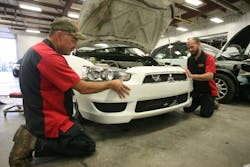Content brought to you by Auto Body Repair Network. To subscribe, click here.
Consider the following scenario. You’re planning to make some very necessary repairs and have three home repair stores where you can go for instructions and the necessary materials and equipment: Home Store A, Home Store B and Home Store C. Each store is a bit different in pricing and offerings. Home Store C is the most affordable but may not offer the best service and products. Home Store B is costlier but a big step up in offerings. Home Store A is the most expensive and has top-tier offerings. Regardless of the store you choose, you can still do a quality repair, though choosing the better store will get you what you need sooner. However, your experience as a shopper also plays a part in the repair work, since the more familiar you are with a store, the sooner you’ll get what you want. At the same time, you’ll need to stay within a budget while completing your repairs in a pretty restrictive time period.
Sounds pretty difficult, huh? If home repairs worked that way, you’d probably go out tomorrow and sell the old homestead for a nice rental. Yet, as a repairer, you face this same challenge every day when you try to access OEM repair instructions. Despite an industrywide effort including significant input from auto manufacturers that has made access to these repairs more widely available than ever, finding the latest repairs (updates included) in a timely effort remains challenging and expensive. And that could prevent some shops from performing the safest, most accurate repair possible.
Don’t risk your shop’s future by faltering in your access efforts. Use the following five tips supplied by some of the industry’s most successful operators to get the right OEM repairs every time and as quickly as possible.
Tip 1: Recognize that great OEM instructions are everywhere.
Kye Yeung, president of European Motor Car Works in Costa Mesa, Calif., says these repairs are available through portals like I-CAR RTS, OEM1Stop, ALLDATA, and from the OEMs themselves. Some sites are free while others charge for subscriptions, with luxury automobile lines typically charging the most. But make no mistake, your repair answers are out there. As long as you have an internet connection, as any service provider should, you have at your fingertips a universe of repair answers. There is no reason to ever make your “best guess” when you’re performing a repair, since the service industry and OEMs have worked together on a number of levels to make OEM information as accessible as possible.
Tip 2: Not all OEM repair portals are created equal...or even similarly.
The challenges that come with choosing a portal have to do with timely updates, entry of service updates, ease of use and even the Internet browser. “All portals are different,” says Barry Dorn, vice president of Dorn Body and Paint in Mechanicsville, Va. “Some want you to use Internet Explorer or Firefox or Microsoft Edge. How you log in and the price you pay vary. There’s zero familiarity from one OEM portal to another. They’re completely different.”
Yeung notes that even “common” areas can differ drastically. “Everyone’s table of contents is different. Manufacturers group things in different areas. Sometimes they put information under the mechanical area,” he says.
Those arguably aren’t the most significant differences you should be aware of that can result in an unsafe or incomplete repair. The most important differences probably lie in the repair instructions themselves.
Yeung notes that not all portals input repair revisions or updates with the same regularity. He says that only those shops on a repair program are guaranteed to get the latest repairs. “We notice sometimes there might be seven updates. You can’t go one size fits all when going from one portal to another,” he says. “You always must ask yourself, ‘Is this the latest update?’”
This fact is exactly why shops shouldn’t try to save money by reusing repair instructions they previously paid for. Dorn notes that simply replacing a quarter panel can require download 500 pages of instructions. That takes time and, if you’re printing these pages out, means lots of money invested in paper and ink. But to ensure a safe repair, it’s a very necessary investment.
This cost is on top of the time required to research and find the correct repair steps, which Dorn says sometimes can take six to eight hours. Again, this investment, too, is a necessity.
Fortunately, there are some ways to reduce and address these costs.
Tip 3: Name a navigation expert.
Adding or naming an OEM portal navigation expert to your staff can be a big help. Ron Reichen, owner of Precision Body and Paint in Beaverton, Ore., says he has one person (and a backup) at each of his business’s four locations who oversee the research work and download repair instructions for each tech. Reichen says having dedicated resources for this work saves time and money. “Sometimes techs have language barriers that can impede their research,” he says. “Also, I don’t want highly trained techs spending hours every day doing research. That’s a very poor use of resources.”
If you don’t think you can afford to pay for this position, there are training options to help your techs, blueprinters and estimators improve their research times. Consultant Mike Anderson says I-CAR offers training here as do some OEMs. His company, Collision Advice, provides free videos on YouTube to assist shops. Anderson additionally notes that every OEM has a telephone number on its portal that repairers can call for assistance. When you do call, Yeung says OEMs are open to making suggested changes to their site to make them easier to navigate.
Still need help getting some clarity on the instructions you want? Yeung suggest reaching out to a dealer you have a relationship with but notes you shouldn’t abuse this relationship by calling too often.
Tip 4: Train regularly.
Regular training provides a number of benefits when it comes to properly using OEM instructions. First, those employees who have up to date training will already be prepared to perform the correct repairs. Second, as such, they should know the ins and outs of the most recent repairs and be more willing to check any updates since they won’t be viewing numerous pages of complex steps for the first time. There will be no shock or intimidation upon handling a sophisticated fix for the first time. Finally, being familiar with current repairs also will save your shop time sorting through repair steps and verifying the correct steps.
Tip 5: Make sure you’re compensated for time spent accessing repairs.
But while you’re saving time this way, make sure you’re charging for time spent researching and accessing OEM repairs. “You have to charge for that time because it isn’t normally factored in,” says Dorn. Yeung repeats this advice, adding, “We always have a line item for the research, but sometimes it gets denied because the third party says it’s part of doing business.”
Hence, when doing the right thing and making sure you’re properly compensated, you’re likely to bump heads with insurers. You may be exhausted fighting this battle, but it’s necessary to cover the hours investing (and potentially lost) accessing the correct steps and performing safe repairs. Yeung notes that losing hours that aren’t compensated is no reason to give up determining the right repair steps, especially since shops are ultimately responsible for a repair.
With vehicles becoming more sophisticated while shops are looking at critical labor shortages and accessing OEM repairs remains a challenge, this might an area where shops, insurers and OEMs can find some common ground. Each party has an interest in providing safe, quality vehicles to customers. Together, they can make this journey easier and better for everyone.
About the Author

Tim Sramcik
Tim Sramcik began writing for ABRN over 20 years ago. He has produced numerous news, technical and feature articles covering virtually every aspect of the collision repair market. In 2004, the American Society of Business Publication Editors recognized his work with two awards. Sramcik also has written extensively for Motor Age and Aftermarket Business World. Connect with Sramcik on LinkedIn and see more of his work on Muck Rack.
